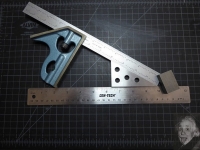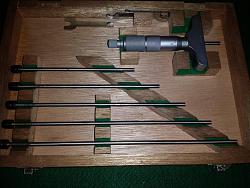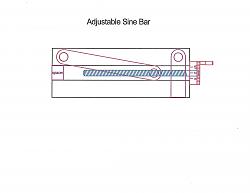This post is more in the nature of a solution looking for a problem. For a long time I've been noodling how to build a tangent bar, an angle setting tool that would, like the sine bar, convert a linear measurement into an accurate angle. The advantage of such a device over the conventional sine bar would be the fact that it could, hopefully, incorporate a bar moved by a precision screw to replace the block stack of the sine bar. This would make it a self-contained instrument without the need for an external height setting mechanism as is the case with the sine bar.
I'm sad to report that so far I haven't pictured a design that didn't have some flaw that would tragically affect its accuracy. However, while rehashing the problem in the shower, I did have an idea - the one presented here - that might have some utility for someone.
My idea revolved around the notion that the typical combination square (CS hereafter) already has everything needed to be a tangent bar. The CS head forms a right angle with the scale and the scale makes one side of the triangle length adjustable. (In the picture below, the CS has been laid against a ruler to form the triangle of which I speak.) The tangent of the angle opposite the CS head is given by:
tan (angle) = (CS head length) / (CS scale length from CS head to ruler)
or, inverted:
(CS scale length) = (CS head length) / tan (angle)
So, to set the angle we measure the CS head length and divide that by the tangent of the desired angle to obtain the amount by which we must expose the CS blade to set the angle.
On the CS shown, the head length is measured to be 3.777 in. Dividing that by tan(30) yields 6.542 in. Now we need to convert .542 in to 32nds (curse the inferial system to hell). 0.542 *32 = 17.34. So, I set the exposure to 6 & 17/32 + a smidgen ("smidgens" are 1/1776 th of an inch, another inferial nonsense unit, this one with patriotic overtones.)
To check the angle, I placed my precision 30-60-90 block in the angle and it fits very nicely.
So, certainly not as accurate as a sine bar although probably better than a cheap protractor. Does it have a use anywhere? Good suggestions are welcome.



 LinkBack URL
LinkBack URL About LinkBacks
About LinkBacks



 Reply With Quote
Reply With Quote












Bookmarks